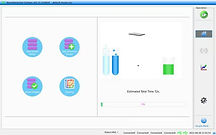top of page
纳米发电机™纳米粒子合成系统
Application Note
PreciGenome NanoGenerator™ 是用于纳米粒子合成的高性能仪器,如脂质纳米粒子、脂质体、PLGA 等,广泛用于药物输送、基因治疗、LNP 配制和制造等。
NanoGenerator™ 生成的纳米粒子具有更好的尺寸均匀性和更小的 PDI。它可从 0.1mL/样品筛选扩展到 1L(>10L 定制设计)大批量 GMP 生产
纳米粒子,尤其是脂质体和聚合物纳米粒子,由于其优异的性能,在药物递送、mRNA疫苗和生物传感等制药工业等各个领域显示出巨大的生物医学应用潜力。
通过微流控技术合成纳米颗粒比传统的批量合成工艺具有优势,因为它能够在尺寸和形状上具有更好的均匀性。例如,在药物递送领域,使用NanoGenerator™纳米粒子合成系统可以合成脂质纳米粒子(LNP)、脂质体、PLGA等多种纳米粒子。脂质纳米颗粒 (LNP)、脂质体和 PLGA 是最常用的可生物降解材料,用于输送亲水性和疏水性化合物。
What is Lipid Nanoparticle?
Lipid Nanoparticles (LNPs) are a class of nanoscale delivery systems designed to transport and protect therapeutic molecules, such as drugs and RNA, to specific target sites within the body. They have gained significant attention in the field of medicine and biotechnology due to their ability to enhance the bioavailability and efficacy of drugs by improving stability and ability to target points of interest for drug delivery. The basic structure of an LNP consists of a lipid bilayer surrounding a hydrophobic core. This structure allows the LNPs to encapsulate hydrophobic drugs or nucleic acids within the core while keeping the hydrophilic components on the surface, making them stable and compatible with the aqueous environment of the body.
粒子合成原理:
Lipid Formulation
NanoGenerator™ 纳米粒子合成系统采用微流体装置进行可控和可调的聚合物粒子生产。下面的示意图说明了在聚焦流几何结构中为粒子合成而设计的结点装置。溶剂置换法用于纳米粒子合成。


Liposomes, a precursor to LNPs, are a highly adaptable nanocarrier platform due to their ability to carry both hydrophobic and hydrophilic molecules, including small molecules, proteins, and nucleic acids. They hold the distinction of being the first nanomedicine delivery platform to transition successfully from theory to clinical use. Several liposomal drug formulations have received approval and have been effectively incorporated into medical practice.
Conventional liposomes are characterized by one or more lipid bilayer rings enclosing an aqueous compartment, but not all LNPs possess a continuous bilayer that would categorize them as lipid vesicles or liposomes. Certain LNPs adopt a structure similar to micelles, sequestering drug molecules within a non-aqueous core. LNPs, which is similar to liposomes, are specifically designed to encapsulate a wide range of nucleic acids (RNA and DNA), making them the most favored non-viral system for gene delivery.
Both liposomes and LNPs have applications in medicine, such as drug delivery and imaging.
Types of LNP and Liposome

In addition to basic liposomes (A) and drug-loaded liposomes (B) which encapsulate a payload within its core, targeted liposomes (C) and stealth liposomes (D) are alternative methods used for drug delivery and treatment. Targeted liposomes (C) have ligands attatched to their surfaces that allow for it to target and bind to specific receptors of cells. These categories of liposomes have beenused for a variety of therapeutic applications such as cancer therapy or against inflammatory diseases like Crohn's disease. However, this comes with the limitation of phagocytes targeting and removing these types of liposomes. Stealth liposomes (D) aim to address this limitation; by coating the outer layer with polymers such as PEG, they are invisible to phagocytes and allow the liposome to avoid the body's natural immune system which can be extremely useful for drug delivery.
In response to the limitations of liposomes, such as their low encapsulation efficiency, new nanoparticle drug delivery systems were developed. Solid lipid nanoparticles (SLN) (F) and nanostructured lipid carriers (NLC) (E)were two types of nanoparticles designed to fill in these gaps. SLN consist of solid lipids, while NLC are formed with a mixture of solid and liquid-crystalline lipids. Both SLN and NLC have particle sizes ranging from 40 to ∼1000 nm and offer improved physical stability compared to liposomes. They also have higher drug loading capacities, better bioavailability, and can be more easily produced at a large scale without the need of organic solvents. Moreover, SLN and NLC can precisely control drug release due to reduced molecular mobility in their solid state.However, one limitation of SLNs is that they can expel drugs during long-term storage due to crystallization. NLC is able to bypass this obstacle by incorporating small amounts of liquid lipids to reduce lipid core crystallinity, resulting in enhanced drug-loading capacity and long-term stability. SLN and NLC are typically manufactured using organic solvent-free techniques, such as high-pressure homogenization, emulsion/solvent evaporation, and solvent injection, minimizing the issues asscoiated with liposome development.
LNP vs Liposome
What is LNP?
粒子合成原理:

How LNP works
粒子合成原理:
NanoGenerator™ 纳米粒子合成系统采用微流体装置进行可控和可调的聚合物粒子生产。下面的示意图说明了在聚焦流几何结构中为粒子合成而设计的结点装置。溶剂置换法用于纳米粒子合成。

iScience doi: 10.1016/j.isci.2021.103479
In the context of mRNA vaccines, LNPs are used as carrier vehicles to protect mRNA molecules from degradation and aid in their intracellular delivery. Some side effects often linked to inflammation, such as pain, swelling, fever, and sleepiness, have been reported in human trials of mRNA-LNP-based vaccines3. These side effects were initially thought to be generated from the potent immune response to the vaccine. However, recent research suggests that the inflammatory nature of the LNPs could be partially responsible for these side effects.
It’s important to note that positively charged lipids, which are often used in LNPs, are inherently toxic. Companies have struggled for years before landing on formulations that were safe and effective. When injected intravenously, these particles invariably accumulate in the liver, and delivery to other organs is still an obstacle.
Therefore, while LNPs have proven to be a crucial component in the success of mRNA vaccines, their potential inflammatory properties and toxicity are areas of ongoing research.
LNP Toxicity
粒子合成原理:
NanoGenerator™ 纳米粒子合成系统采用微流体装置进行可控和可调的聚合物粒子生产。下面的示意图说明了在聚焦流几何结构中为粒子合成而设计的结点装置。溶剂置换法用于纳米粒子合成。

These components form a lipid shell surrounding an internal core composed of reverse micelles that encapsulate and deliver oligonucleotides, like siRNA, mRNA, and plasmid DNA. The success of mRNA-based COVID-19 vaccines could not have been possible without decades of research on lipid-based drug delivery (LBDD) systems, a subset of which are LNPs.
Table Lipid molar ratios for LNPs in FDA-approved agents
* Ionizable/cationic lipid : neutral phospholipid : cholesterol : PEGylated lipid
How make LNPs
粒子合成原理:

Preparatin Protocol
演示视频和网络研讨会:
纳米发电机™Flex-M演示视频
纳米发电机™ProMab Biotechnologies 的 LNP 合成与应用网络研讨会
Introduction Videos
bottom of page






